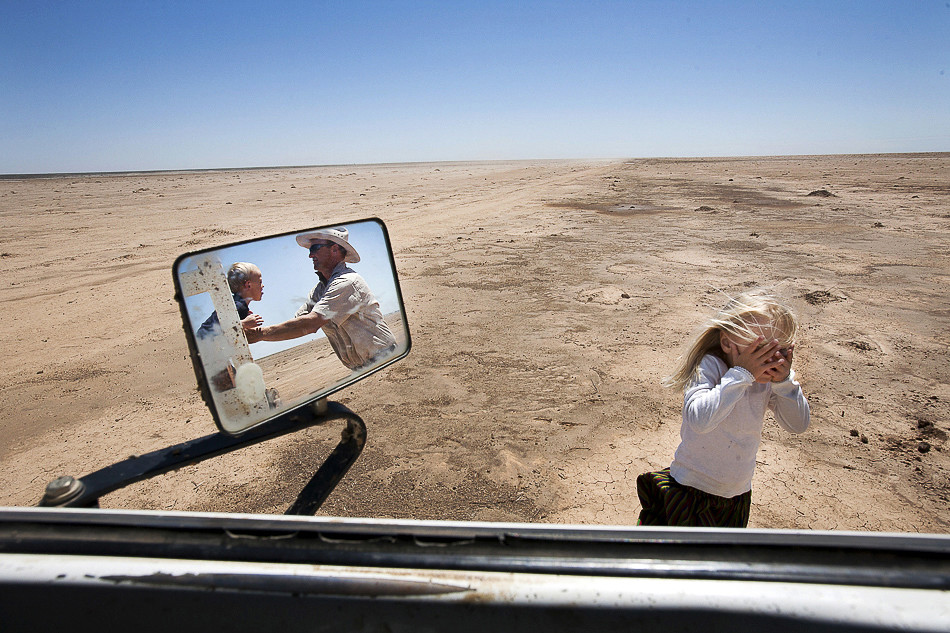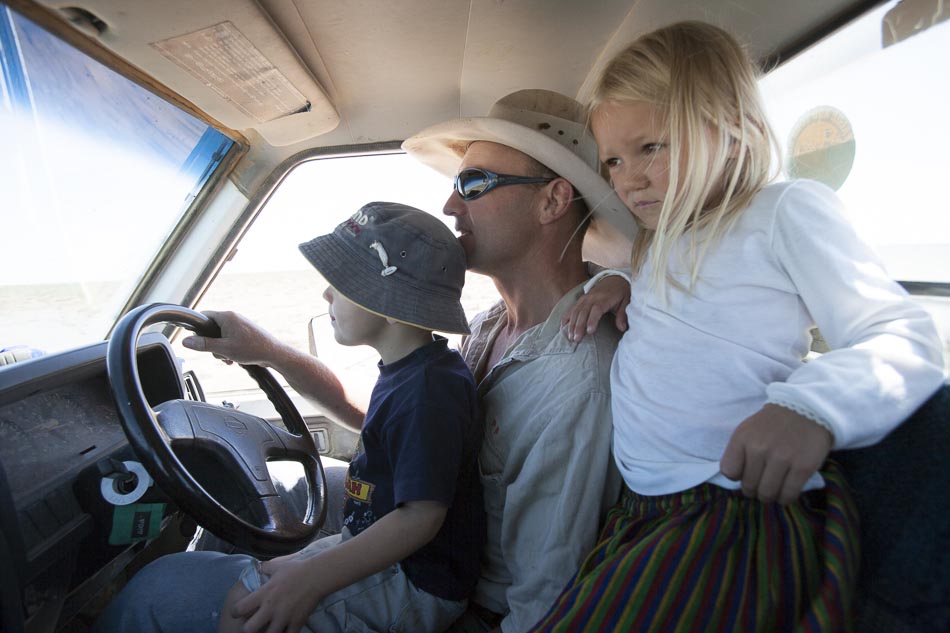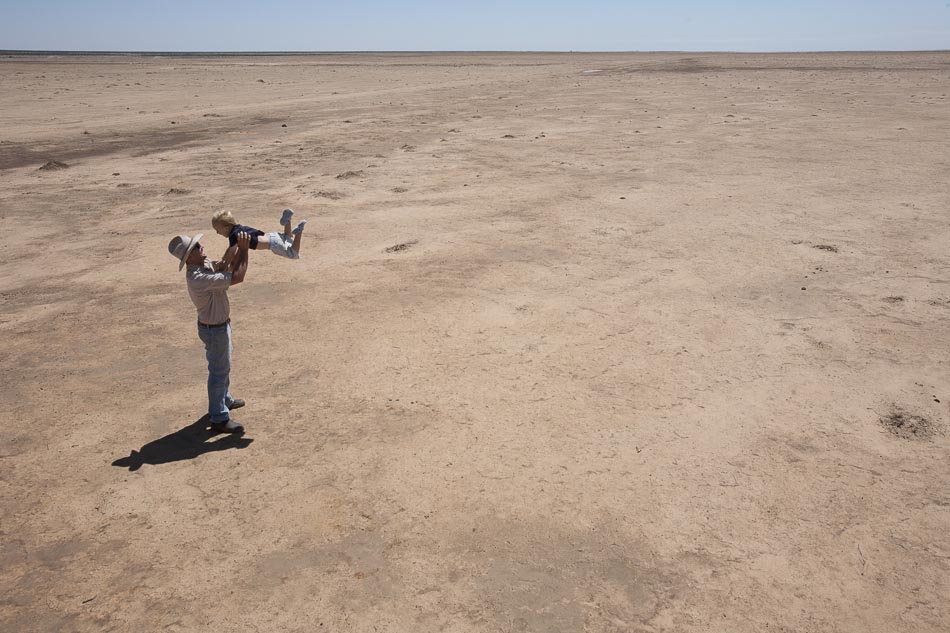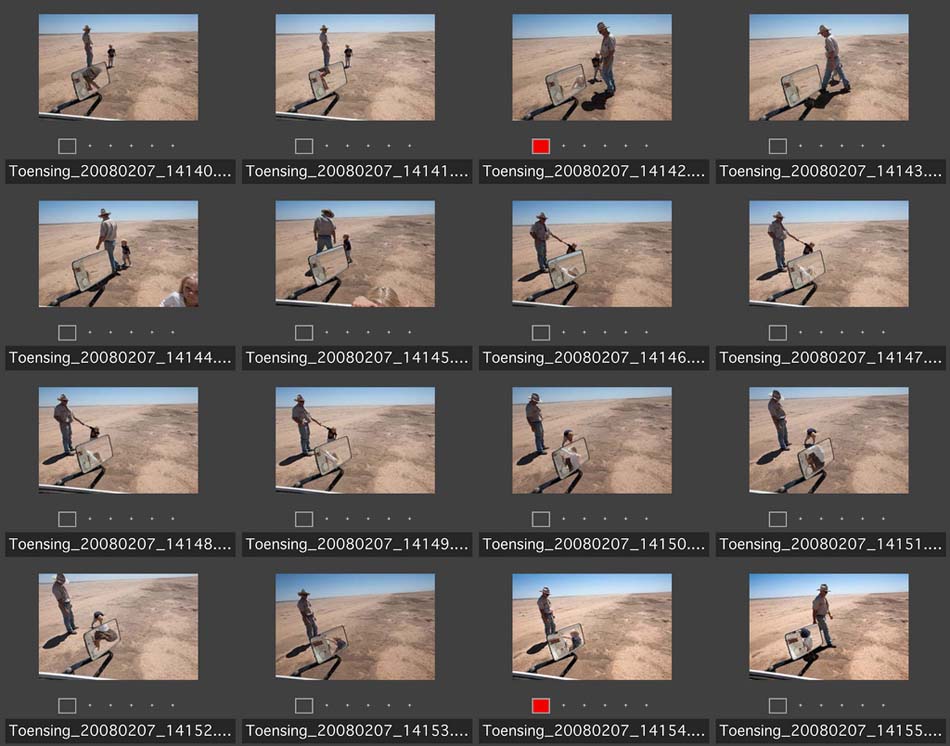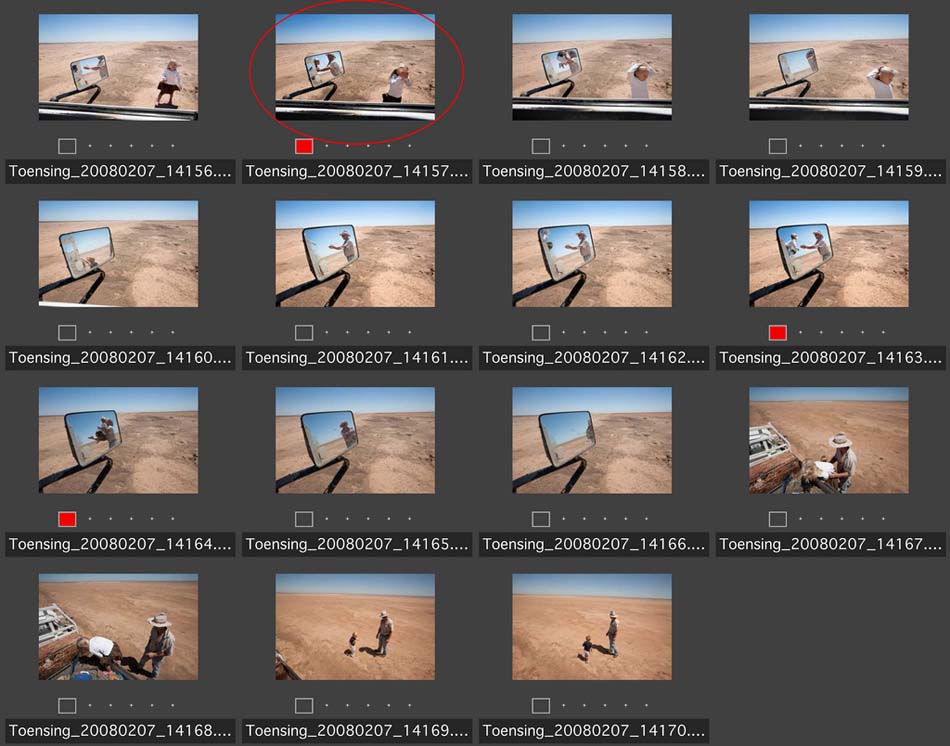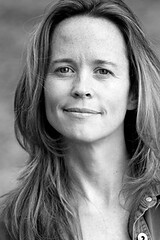Spotlight on Amy Toensing
Feb 25, 2013
TID:
This is such an instant classic, Amy, can you give us a little background to the story this image is a part of?
AMY:
This image is from a story I was assigned to by National Geographic magazine in 2007. A region known as the Murray-Darling Basin was besieged by drought for over a decade or more. While the country is no stranger to severe weather, the length of the drought was unprecedented in recorded history. NGM assigned me to put a human face on it.
TID:
Tell us what led up to the moment and what was going on in your mind when you made the image.
AMY:
I’m usually not “in my mind” when I make photographs - I’m just in the moment, but overall I was looking for ways to show the landscape with emotion and for me that means adding humanity. I met up with the Booth family at their house for an introduction. We were going to sit at the kitchen table and talk about their experience with farming in the context of the drought. Instead, when I arrived, Simon Booth immediately invited me to take a ride with him and his kids out to their paddocks. It had rained the night before, more than it had in years in one storm, and they wanted to see how the land fared and get a measurement on their rain gauge.
Heavy rain isn’t always a good thing when you’re in the middle of a drought. The land is so dry and at the time, the little bit of green growth was delicate so the pounding rain destroyed most of it. We stopped at a spot that Simon said had once been a paddock of endless green that fed his herd. The kids got out and began running around. Their dad joined and I followed. I decided I needed a different lens and went back in the cab of the truck to my bag. As I was changing the lens, I looked out the window and saw this scene starting to unfold. I followed it until this image happened. I was just present and therefore rewarded - but I was lucky, too.
TID:
Mentally what is it like preparing for a long-term story with National Geographic? Is it different when working on a long-term story for yourself or other clients verses NGM?
AMY:
The biggest difference is that NGM funds longer term stories, unlike most publications these days, so I would say it’s a luxury to know I will be funded for the project’s completion. Beyond the budget distinction, I would say differences are more about the subject matter than who I am working for. Every story is different and each one requires a unique approach.
TID:
How much time did you have to prepare for this story before you traveled to photograph it? How long did you work on this story before it was finished? How long after the story was finished before it was published?
AMY:
I believe I had about 3 weeks of research time, but because the geography of this story was so broad and remote, I spent most of my research time in the field making contacts. I was able to travel throughout the basin for about 10 days with a scientist who was studying the effects of the drought. I shot during this time, but I also considered it research time. I read a number of books about climate change and as always, I kept up with any news articles.
I believe I had about 8 weeks of shooting time for this assignment. I don’t remember how long it was between being finished and being published. It’s always laid out 6 months from publication, so it was at least that.
TID:
In your work over the years, there is almost always a decisive moment, “the” frame. Is there something that you can attribute to mentally/emotionally that helps able you to consistently capture the perfect moment?
AMY:
I wish I did always capture the perfect moment!! There is a great deal of work behind the frames you see in publications. I would say what helps is the research and other work I do to build my understanding of the story and my subjects. Then when I get in the field I am looking for distinct ideas of what I want to say, so I recognize what I want when I see it and then I focus on it. These ideas of what I want tend to be thematic and broad, and I am always looking for something that suggests as opposed to straight documentation. A successful image to me is more metaphoric about an issue or an aspect of the story. It leaves room for the viewer to add their own imagination to the frame and feel what the image is saying.
TID:
Was there any point of conflict or struggle during the making of this picture, and how did you handle it? Specifically about this image and if not, during the shooting of other parts of the story?
AMY:
I was having a very big struggle at the time making this image. I was covering a drought and the region I was in was getting blasted by thunderstorms. They call it a “green drought” because grass actually starts to grow from the immediate rain, but the water table was still horribly low and the end of the drought was nowhere in sight. However, you wouldn’t be able to determine this from a photograph since the region looked green.
TID:
What lessons did you learn from making this image?
AMY:
It reinforced how important it is to allow the story to speak and to not get too stuck in my head. Even if it seems like a picture is nowhere to be found, there might be one just around the corner, but it won’t happen if you stop yourself before you get there. From the road, the land looked green and impossible for showing drought, but the storms were in pockets, so when I got to the Booth farm the reality of the drought was ubiquitous.
TID:
Was there anything that surprised you about the experience?
AMY:
Just that I got a picture that day - because of the rain, the most I was expecting from my meeting with the Booths was making another contact and gathering some more background for the story.
Researching the story and interviewing people requires me to be in my mind. I need to comprehend the intellectual aspects of the subject matter. Examples for this particular story would be learning about the water distribution system for farmers, the types of crops in the region, what each crop required and how the drought was playing out in Australian politics to name a few. I also read material about climate change and differing opinions on whether this drought was part of a shifting global climate. As a journalist, it’s my job to understand what the issues are. This knowledge informs my approach and helps me determine where to go in search of images.
TID:
You said, "I’m usually not 'in my mind' when I make photographs - I’m just in the moment." I really like that idea. Can you expand more on what you mean by this?
AMY:
It’s important for me to be both “in my mind” and very much “not in my mind” while working on a story. There is a time and place for each and they are both essential, however creating the space to be “not in my mind” can sometimes be challenging while negotiating the pressures of working for a publication. It also requires a level of letting go and allowing the story to speak to me.
When I am making pictures, I need to find the space to be “not in my mind.” So I often have to tell myself to “get out of my head.” It’s about getting to a place where I am connecting to the subject on a basic and emotional level: light, shapes, color and raw emotion. I am taking them in. It’s very distinct to be in and out of that space - and it feels clear and good to be in it. I think many artists and athletes, etc. call it “being in the zone.” It’s challenging to get in this space for many reasons - you can’t just check-out from your subject and being in this zone sort of requires that, so I find it easier to get in this space when the subject has forgotten about me.
It takes time to be in someone’s space and get to a place where they forget about you. It can also be challenging to get into this space because of pressures from the publication or maybe there is a direction that the editors have given and it gets in my head. I like to take in feedback and direction when I am “in my mind” that way I can consider it and make it own. When I am in the field I need to be very closely in touch with my own vision.
Researching the story and interviewing people requires me to be in my mind. I need to comprehend the intellectual aspects of the subject matter. Examples for this particular story would be learning about the water distribution system for farmers, the types of crops in the region, what each crop required and how the drought was playing out in Australian politics to name a few. I also read material about climate change and differing opinions on whether this drought was part of a shifting global climate. As a journalist, it’s my job to understand what the issues are. This knowledge informed my approach and helped me determine where to go in search of my images.
TID:
How does this image make you feel when you look at it now?
AMY:
Images on this assignment were few and far between. This was the nature of the story given the vast and scarcely populated landscape. I feel satisfied because I made a picture that shows the impact of the drought on the land and people on an emotional level.
TID:
You said, "images on this assignment were few and far between." Can you talk about the importance of patience, and how you deal with the down time between making pictures (which can often be a lot)?
AMY:
The area I was required to cover for this story was the size of Spain and France combined, so the geographical expanse had impact. This was good and bad. The difficult part was the travel required and how it cut into the amount of time I had to get the assignment done. Most assignments require a great deal of logistical work: travel, scheduling shoots and interviews, and on the ground research. This can get frustrating when all you want to do is shoot and make pictures. Additionally, weather can really put a hold on things (like “green droughts.”)
All that said, I think every photographer ALWAYS wishes for more time shooting! When I’m not out making pictures, I feel like a racehorse stuck at the gate - my gear is all ready, I understand the story and I know what I want - but I am pinned. I do better when I am thoughtful and not stressed about utilize the time when I am not shooting. That time might mean editing or doing more research. But sometimes, if I have been in the field a long time, the best thing for me to do is walk away from “working” on the story and instead try participate in the landscape I am covering: walk through it, go hang out with one of my subjects or dive in the water and go for a swim.
TID:
In conclusion, can you share some advice to others who may want to cover long-term stories when on assignment?
AMY:
Take the time to research and understand your story/subjects. When you get in the field give yourself the space to get out of your head and tell the story on an emotional level. Have a good understanding of your story and work to illustrate it in a nonliteral way.
:::BIO:::
Amy Toensing, an American photojournalist committed to telling stories with sensitivity and depth, is known for her intimate essays about the lives of ordinary people.
Toensing has been a regular contributor to National Geographic magazine for over a decade and recently completed her thirteenth feature story for them. She has covered cultures around the world including the last the cave dwelling tribe of Papua New Guinea, the Maori of New Zealand and the Kingdom of Tonga. She has also covered issues such as the devastation caused by Hurricane Katrina and Muslim women living in Western culture. For the last 3 years she has been documenting Aboriginal Australia.
Toensing began her professional career in 1994 as a staff photographer at her hometown paper, The Valley News, in New Hampshire. She then worked for The New York Times, Washington D.C. bureau covering the White House and Capitol Hill during the Clinton administration. In 1998, Toensing left D.C. to receive her Master’s Degree from the School of Visual Communication at Ohio University.
In addition to her photojournalism work, Toensing is committed to teaching photography to kids and young adults in underserved communities. This includes working with the non-profit organization VisionWorkshops on numerous projects including teaching Somali and Sudanese refugees in Maine and Burmese refugees in Baltimore photography. Last year she traveled to Islamabad to teach young Pakistanis photojournalism and cover their own communities.
WEBSITE
http://www.amytoensing.com/
KICKSTARTER PROJECT (until 3/15/13)
http://kck.st/VGdAUS
The Photo Society
http://thephotosociety.org/member/amy-toensing/
BLOG
www.moyer-toensing.com
WORKSHOPS
NATIONAL GEOGRAPHIC PHOTO WORKSHOP // SANTA FE Sept 22-28, 2013
http://www.nationalgeographicexpeditions.com/experts/amy-toensing/detail
POETIC STORYTELLING w/ SANTA FE PHOTOGRAPHIC WORKSHOPS // San Miguel de Allende, October 20-26, 2013
http://www.santafeworkshops.com/
Editor's Note:
This week's interview was conducted by Pattie McNab who runs her own visual media company, McMushroom Media, which includes PJ Photo Editors, a consultancy that helps professional photographers reach their full potential. Before working for herself Pattie was a photo editor at The AP and Getty Images, collaborating with photographers on spot news and longer-term photo stories. She lives in NYC with her husband and two children.
If you're interested in being a guest interviewer, please contact: [email protected]
